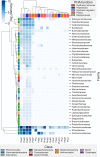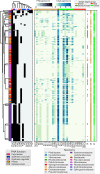In silico identification of bacterial seaweed-degrading bioplastic producers
- PMID: 36125959
- PMCID: PMC9676036
- DOI: 10.1099/mgen.0.000866
In silico identification of bacterial seaweed-degrading bioplastic producers
Erratum in
-
Erratum: In silico identification of bacterial seaweed-degrading bioplastic producers.Microb Genom. 2024 Feb;10(2):001195. doi: 10.1099/mgen.0.001195. Microb Genom. 2024. PMID: 38421378 Free PMC article. No abstract available.
Abstract
There is an urgent need to replace petroleum-based plastic with bio-based and biodegradable alternatives. Polyhydroxyalkanoates (PHAs) are attractive prospective replacements that exhibit desirable mechanical properties and are recyclable and biodegradable in terrestrial and marine environments. However, the production costs today still limit the economic sustainability of the PHA industry. Seaweed cultivation represents an opportunity for carbon capture, while also supplying a sustainable photosynthetic feedstock for PHA production. We mined existing gene and protein databases to identify bacteria able to grow and produce PHAs using seaweed-derived carbohydrates as substrates. There were no significant relationships between the genes involved in the deconstruction of algae polysaccharides and PHA production, with poor to negative correlations and diffused clustering suggesting evolutionary compartmentalism. We identified 2 987 bacterial candidates spanning 40 taxonomic families predominantly within Alphaproteobacteria, Gammaproteobacteria and Burkholderiales with enriched seaweed-degrading capacity that also harbour PHA synthesis potential. These included highly promising candidates with specialist and generalist specificities, including Alteromonas, Aquisphaera, Azotobacter, Bacillus, Caulobacter, Cellvibrionaceae, Duganella, Janthinobacterium, Massilia, Oxalobacteraceae, Parvularcula, Pirellulaceae, Pseudomonas, Rhizobacter, Rhodanobacter, Simiduia, Sphingobium, Sphingomonadaceae, Sphingomonas, Stieleria, Vibrio and Xanthomonas. In this enriched subset, the family-level densities of genes targeting green macroalgae polysaccharides were considerably higher (n=231.6±68.5) than enzymes targeting brown (n=65.34±13.12) and red (n=30.5±10.72) polysaccharides. Within these organisms, an abundance of FabG genes was observed, suggesting that the fatty acid de novo synthesis pathway supplies (R)-3-hydroxyacyl-CoA or 3-hydroxybutyryl-CoA from core metabolic processes and is the predominant mechanism of PHA production in these organisms. Our results facilitate extending seaweed biomass valorization in the context of consolidated biorefining for the production of bioplastics.
Keywords: PHA; algae; bioplastic; genome; macroalgae; marine; polyhydroxyalkanoates; seaweed.
Conflict of interest statement
The authors declare that there are no conflicts of interest.
Figures






Similar articles
-
Current application of algae derivatives for bioplastic production: A review.Bioresour Technol. 2022 Mar;347:126698. doi: 10.1016/j.biortech.2022.126698. Epub 2022 Jan 11. Bioresour Technol. 2022. PMID: 35026424 Review.
-
Green alternatives to petroleum-based plastics: production of bioplastic from Pseudomonas neustonica strain NGB15 using waste carbon source.Environ Sci Pollut Res Int. 2024 May;31(21):31149-31158. doi: 10.1007/s11356-024-33309-7. Epub 2024 Apr 16. Environ Sci Pollut Res Int. 2024. PMID: 38625463 Free PMC article.
-
Biosynthesis of Polyhydroxyalkanoates (PHAs) by the Valorization of Biomass and Synthetic Waste.Molecules. 2020 Nov 26;25(23):5539. doi: 10.3390/molecules25235539. Molecules. 2020. PMID: 33255864 Free PMC article.
-
One-pot polyhydroxyalkanoate (PHA) production from Cerbera odollam (sea mango) oil using Pseudomonas resinovorans: Optimal fermentation design and mechanism.J Environ Manage. 2025 Mar;376:124394. doi: 10.1016/j.jenvman.2025.124394. Epub 2025 Feb 8. J Environ Manage. 2025. PMID: 39921954
-
Polyhydroxyalkanoates, the bioplastics of microbial origin: Properties, biochemical synthesis, and their applications.Chemosphere. 2022 May;294:133723. doi: 10.1016/j.chemosphere.2022.133723. Epub 2022 Jan 24. Chemosphere. 2022. PMID: 35085614 Review.
Cited by
-
Polyhydroxybutyrate production by recombinant Escherichia coli based on genes related to synthesis pathway of PHB from Massilia sp. UMI-21.Microb Cell Fact. 2023 Jul 14;22(1):129. doi: 10.1186/s12934-023-02142-x. Microb Cell Fact. 2023. PMID: 37452345 Free PMC article.
References
-
- Lebreton L, Andrady A. Future scenarios of global plastic waste generation and disposal. Palgrave Commun. 2019;5:11. doi: 10.1057/s41599-018-0212-7. - DOI
Publication types
MeSH terms
Substances
LinkOut - more resources
Full Text Sources
Molecular Biology Databases

